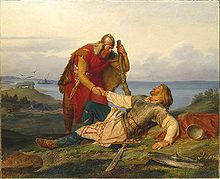Hjalmar and Ingeborg

Hjalmar and Ingeborg was a legendary Swedish couple. The male protagonist Hjalmar and his duel for Ingeborg figures in the Hervarar saga and in Orvar-Odd's saga, as well as in Gesta Danorum, Lay of Hyndla and a number of Faroese ballads. Hjalmar never lost a battle until meeting a berserker wielding the cursed sword Tyrfing.
A tale of two heroes

Hjalmar was one of the mythical Swedish king Yngvi's housecarls at Uppsala. He and princess Ingeborg were in love, but the king said no to his requests for marriage, since he hoped for a suitor with a better pedigree.
Hjalmar's reputation as a courageous and valiant warrior was great and it reached the most remote parts of Norway, where the Norwegian hero Orvar-Odd felt a desire to test his fighting skills with Hjalmar. Thus Orvar-Odd sailed to Sweden with five ships and met Hjalmar who had fifteen ships. Hjalmar could not accept such an uneven balance of strength and sent away ten of his own ships so that the forces would be even. The two warriors fought for two days with a lot of blood-letting and poetry, but it was a draw. Finally, they realized that they were equals and decided to become Blood brothers by letting their blood flow under a strand of turf raised by a spear. Then the strand of turf was put back during oaths and incantations. Orvar-Odd accompanied Hjalmar back to Uppsala, where he soon discovered the feelings between Hjalmar and Ingeborg. Orvar-Odd offered to help Hjalmar elope with Ingeborg, but Hjalmar declined and suffered patiently until a suitor arrived that Hjalmar could not tolerate.
The sons of Arngrim
Further south, on Bolmsö, lived the feared berserker Arngrim and his twelve sons. They were all infamous berserkers who spread fear and destruction throughout the North. The eldest was a head taller than the rest and his name was Angantyr, and it was to him that Arngrim had entrusted the sword Tyrfing, which had been cursed by its makers, the Dwarves Dvalinn and Durin. This sword would cause three evil deeds and one man had to die every time it was unsheathed. The next eldest was Hjorvard and one Yule, when everyone was at home and bragged about what they would accomplish the following year, Hjorvard declared that he was to marry princess Ingeborg at Uppsala.
The proposal

In the spring, the twelve brothers arrived at Uppsala and Hjorvard asked for Ingeborg's hand, but this was something Hjalmar would not tolerate. Hjalmar stepped forth and said that he deserved the princess more than a strange berserker. The king who was uncomfortable with having twelve infamous berserkers in his hall declared that he could not possibly choose between two so great men, and thus he preferred to let Ingeborg make the choice herself. Naturally, Ingeborg chose Hjalmar and this vexed Hjorvard who challenged the happy Hjalmar to a duel on Samsø, and reminded that Hjalmar would be niðingr, if he did not turn up.
The duel on Samsø
On the designated day, Hjalmar and Orvar-Odd arrived to Munarvágr on Samsø, and immediately stepped ashore to search for their adversaries. They soon found the scattered and gory remains of the crewmen, who had been slaughtered by the twelve berserkers. Orvar-Odd immediately went to the forest and cut himself a huge club (according to Saxo, he took a rudder), whereupon the two companions continued their search for the twelve brothers.
Orvar-Odd who wore a silken mailcoat which nothing could pierce (cf. mithril) offered to take on Angantyr who wielded the cursed sword Tyrfing, but Hjalmar insisted on doing it himself. Orvar-Odd quickly expediated Hjorvard and ten of the brothers, and started to look for Hjalmar. He found Angantyr dead, but Hjalmar was sitting on a hill covered with flowers, lethally wounded by Tyrfing. Hjalmar was singing about his impending death and about Ingeborg.
Aftermath

Orvar-Odd buried all the slain men in barrows and Tyrfing as well so as to ensure that it would not cause a second and third malicious deed, after Hjalmar's death. Then he sailed alone back to Uppsala with Hjalmar's corpse. He entered the hall and handed the ring to Ingeborg, who looked at the ring and fell down dead. The two lovers were buried in the same barrow.
Tyrfing would not remain buried. For its continued adventures, see Hervor.
External links
- Translations of Faroese ballads on Hjalmar
- N. Kershaw's English translation of the Hervarar saga
- A collection of translation by N. Kershaw of Norse sagas and ballads
- The Danish historian Saxo Grammaticus on Hjalmar
- Tunstall's translation of the battle, from Orvar-Odd's saga
![]() This article contains content from the Owl Edition of Nordisk familjebok, a Swedish encyclopedia published between 1904 and 1926, now in the public domain.
This article contains content from the Owl Edition of Nordisk familjebok, a Swedish encyclopedia published between 1904 and 1926, now in the public domain.
